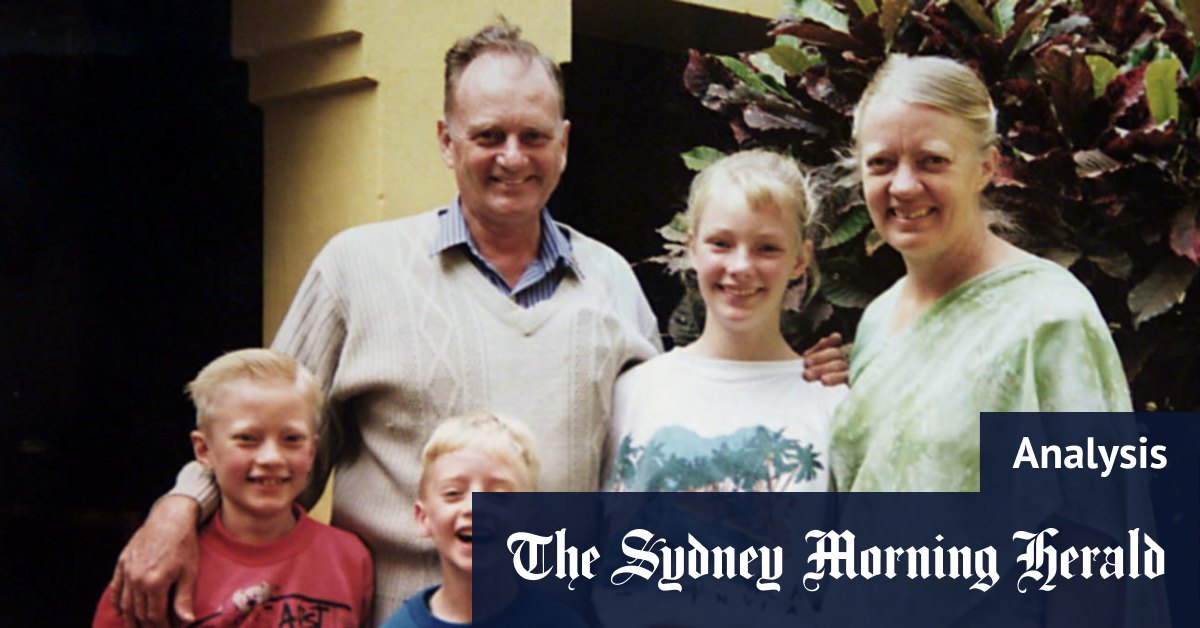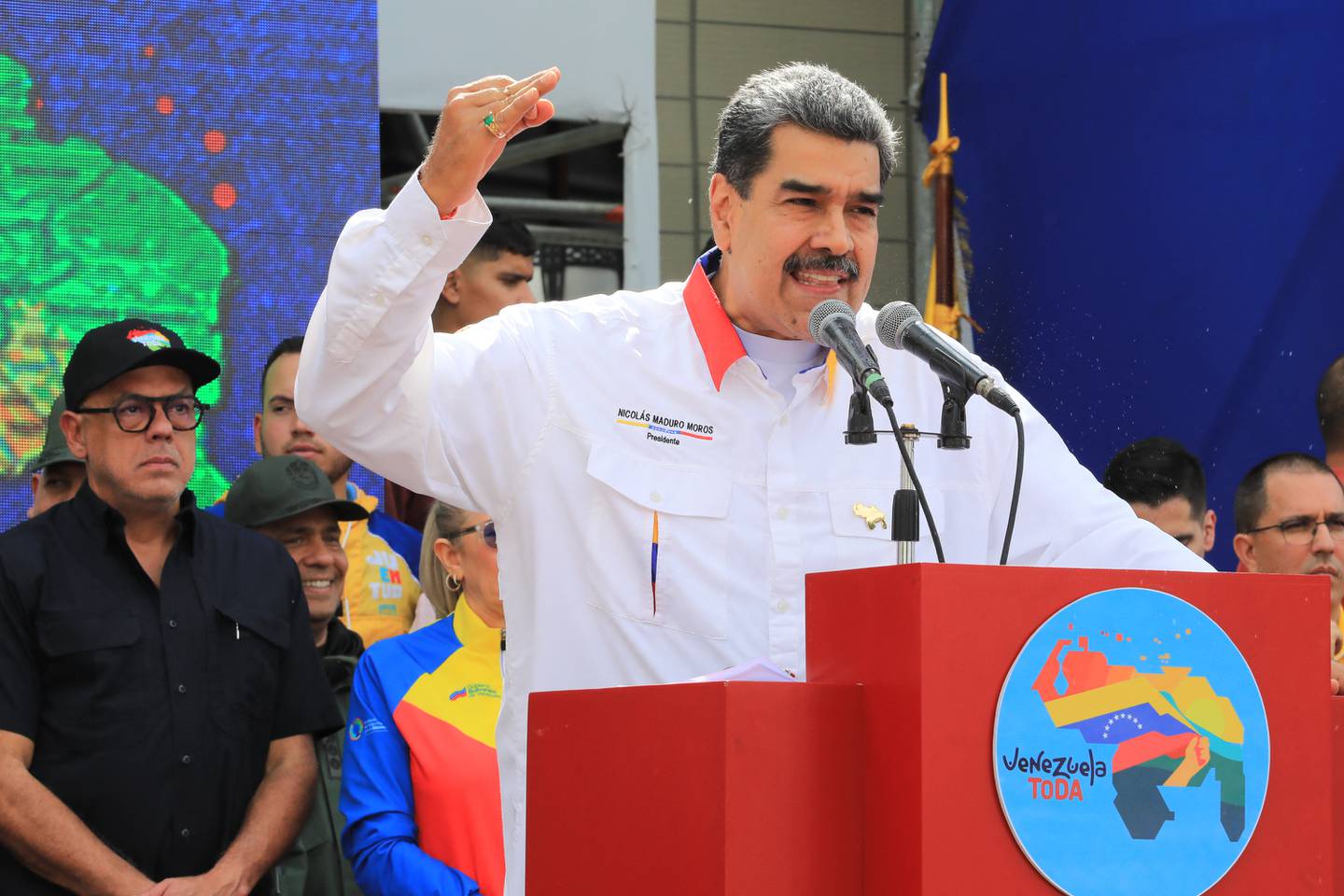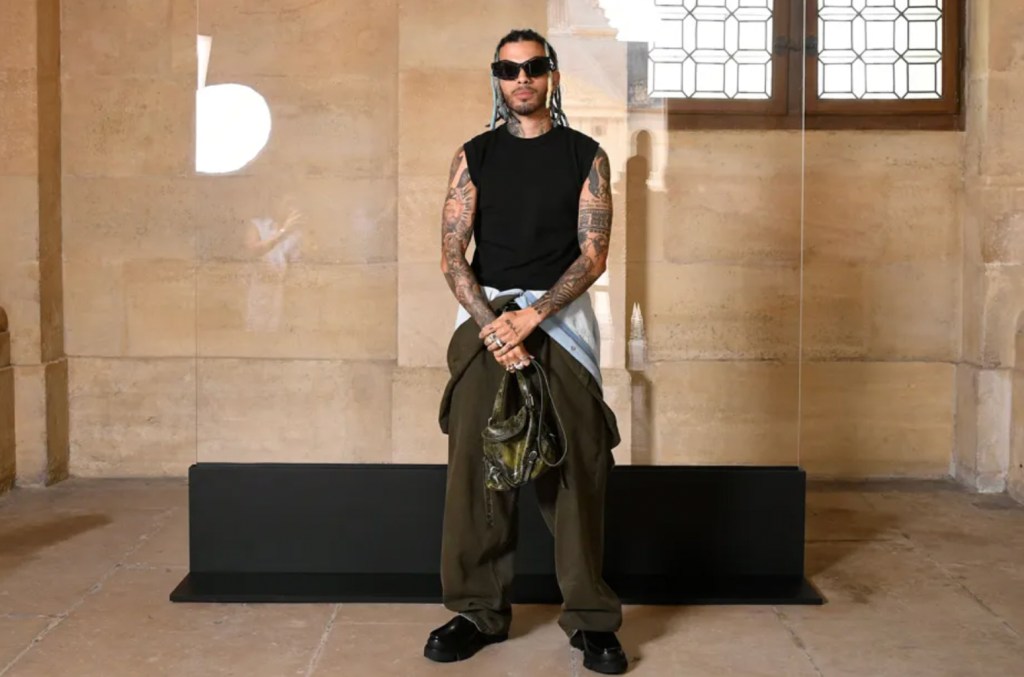Australians of a certain age may recall the story of Graham Staines, a Christian missionary murdered alongside his young sons, Philip and Timothy, by Hindu extremists in the remote eastern lands of India.
Staines had been living for decades in what is now the state of Odisha, caring for leprosy patients and the poor with the Missionary Society of Mayurbhanj, a Baptist group with origins in Queensland.
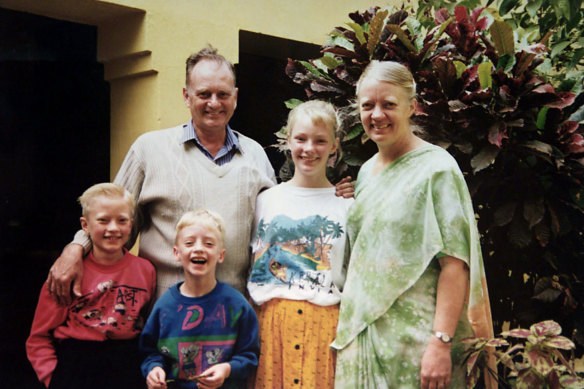
Graham and Gladys Staines with their children Philip (left), Timothy and Esther in 1998.Credit: AP
On January 22, 1999, Staines and the boys were on a road trip to a camp and had stopped to sleep for the night outside a church in the village of Manoharpur. A mob torched their vehicle.
It was figured Staines had been forcing tribal villagers to convert to Christianity – a spiritual offence against the exclusionary movement of Hindutva, which holds Hinduism as inseparable from the very idea of Indian nationhood and purity. A subsequent Indian inquiry found Staines had done no such thing.
While still at-large afterwards, mob leader Dara Singh murdered a Christian priest and rallied another group in cutting off the arms and setting fire to a Muslim trader, who died. Singh and others are serving life-sentences in jail.
The attacks were of the militant extreme. But religious violence in India is not uncommon. Even in softer forms, Hindutva foments the marginalisation of minorities – particularly the country’s 200-plus million Muslims – and jars with its secular Constitution.
It is also the foundational philosophy of the ruling Bharatiya Janata Party (BJP) and its nationalist Prime Minister Narendra Modi.
Close to a billion Indians are eligible to vote in a seven-phase national election beginning on Friday, April 19, and ending on June 1. It will be the largest democratic exercise in the history of civilisation.
Modi’s BJP has been in power for the last decade, having captured nationalists and the vast voting bloc of the Hindu north. Despite a mixed economic record and a widening rich-poor divide, it has presided over a period of collective growth, modernisation and international influence. Modi and his public relations juggernaut, presenting the prime minister as humble yet deity-like saviour, have enmeshed his brand with the nation’s rise.
Among the ardent, criticism is a form of blasphemy.
Sydney experienced Modimania firsthand in May last year during a prime ministerial visit.
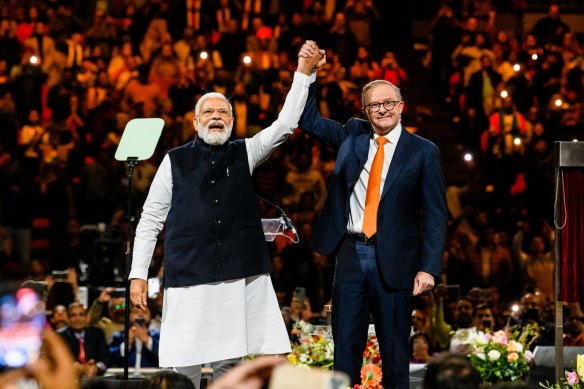
Narendra Modi on stage with Prime Minister Anthony Albanese in Sydney in May last year. Credit: James Brickwood
“The last time I saw someone on this stage was Bruce Springsteen, and he did not get the welcome that Prime Minister Modi has got,” Australian Prime Minister Anthony Albanese proclaimed to the diaspora at Qudos Bank Arena.
“Prime Minister Modi is the Boss!”
University of Melbourne lecturer Dr Pradeep Taneja says Modi has won over many of the poor by helping them open bank accounts and by repackaging subsidy schemes. Cooking gas, for example, used to be discounted at the retail counter.
Loading
“What happens now is that now you pay the full market price, but then within 24 hours the government subsidy goes directly into your bank account – so you can actually see cash going in,” Taneja says.
“There’s a lot of these schemes that appeal to people in north India, particularly in Uttar Pradesh and Bihar, which together have nearly 125 seats [in parliament] … and where there is a lot of poverty.”
Deeper than this, writes Professor Ramachandra Guhu in Foreign Affairs, Modi’s supporters “proudly boast that India has rediscovered and reaffirmed its Hindu civilisational roots, leading to a successful decolonising of the mind – a truer independence than even the freedom movement led by Mahatma Gandhi achieved.
“The prime minister’s speeches are peppered with claims that India is on the cusp of leading the world.”
Aiding the BJP is a weakened opposition coalition called the Indian National Development Inclusive Alliance – anything to manufacture the acronym INDIA.
The main partner is the Indian National Congress Party, led by political scion Rahul Gandhi (no relation to Mahatma). It has run the country for much of its independence, and carries a stink from its time in government immediately before the BJP.
As for Gandhi, the ANU’s Dr Stuti Bhatnagar says he has long been dogged by a narrative, played by the BJP, of owing his status to his powerful family rather than merit.
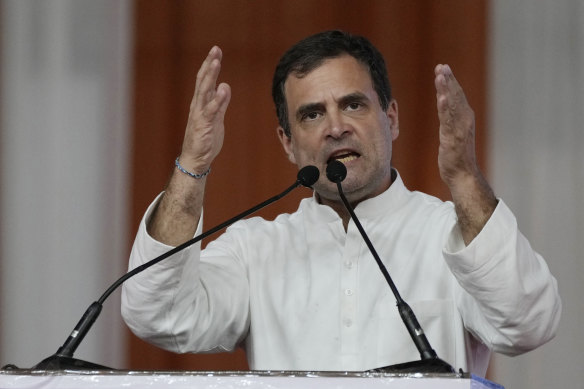
India’s opposition Congress party leader Rahul Gandhi.Credit: AP
But the Modi reign has been marked by an erosion of democratic norms, observers say. Some established media organisations have been cowed into fawning coverage, or bought by BJP business allies like billionaire Gautam Adani (he of Queensland coal mine fame). Journalists airing unfavourable angles have been menaced by the party or institutions of state.
Modi’s populist government has jailed dissenting voices, including Delhi Chief Minister Arvind Kejriwal, and has been accused of freezing the cash of the already on-the-nose opposition.
Polls suggest it will easily win a third term.
***
The Staines murders have not been forgotten in India, particularly among the people of Odisha. They gather each January 22 to honour the family and Graham’s life’s work. According to local media reports, this year, the 25th anniversary, was especially large.
As the villagers assembled in Manoharpur, Modi was some 1000 kilometres away in the city of Ayodhya reclaiming a holy site and pushing a Hindutva version of India into “new era” free of colonial baggage and lingering national timidity.
The consecration of the still-unfinished grand temple to Ram, a long-held and once impossible-seeming Hindu ambition, was “the holiest of moments”, Modi told the heaving crowd. Religious Hindus believe Ram was born here.
While the January 22 date may have been coincidental, Modi’s sermon, laced with Hindu epithets and supplications, carried an explicit message for India’s religious minorities.
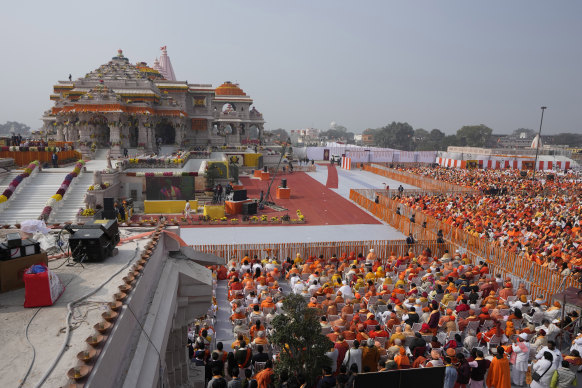
Narendra Modi’s inauguration of a controversial Hindu temple was seen as the unofficial start of his re-election campaign.Credit: AP
“This temple … is the manifestation of Bharat’s [India’s] vision, philosophy and insight,” he said. “It is a temple of national consciousness in the form of Lord Ram. Ram is the faith of Bharat. Ram is the foundation of Bharat. Ram is the thought of Bharat. Ram is the constitution of Bharat.”
The temple, he said, was also “a symbol of inspiration for every section of society”. Presumably, this meant every section of the prevailing 80 per cent religious majority: Muslims were unlikely to find inspiration in a temple constructed on the rubble of a centuries-old mosque torn down in 1992 by right-wing Hindus.
Modi was born into relatively low status on September 17, 1950 in Gujarat, a state he would later lead as chief minister, including during deadly ethnic riots in 2002 in which an estimated 1000 people, mostly Muslims, died. (A BBC documentary explored Modi’s actions of the time. Tax officials raided the broadcaster’s Indian offices weeks after it aired).
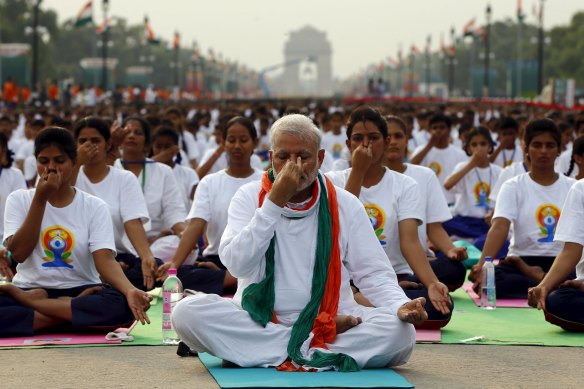
Prime Minister Narendra Modi leads a yoga session to mark the International Day of Yoga, in New Delhi in 2015.Credit: Reuters
His website proclaims his early years were “marked by his association with the Rashtriya Swayamsevak Sangh (RSS), a Hindu nationalist organisation”, whose meetings he attended from the age of eight “after a day’s work at the family tea stall”. Modi quickly rose through the ranks and was thrust into BJP politics.
The RSS, which gave birth to the BJP and militant offshoots, has millions of adherents and will turn 100 next year.
Dara Singh, of the Staines murders, was said to have attended RSS rallies and campaigned for the BJP. It was a former RSS member, disowned by the organisation, who was responsible for the assassination of Mahatma Gandhi. Former senior figures publicly admired Adolf Hitler and Benito Mussolini, though the organisation has since distanced itself from such language, positioning itself instead as an anti-authoritarian and benevolent keeper of Hindu values.
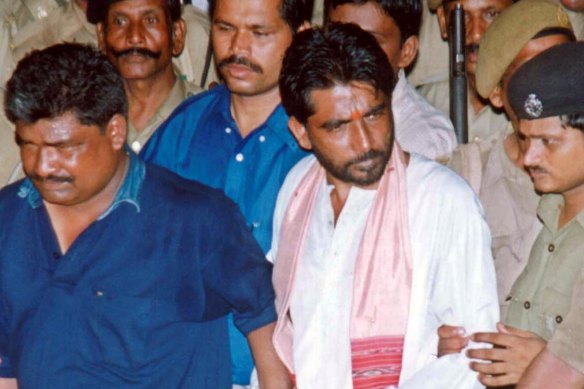
Dara Singh, centre in white, is escorted from the court in Bhubhaneshwar, India, in 2003. His death sentence was later commuted to life.Credit: AP
In his 2015 book, The Modi Effect, Lance Price makes the reasonable point that most political parties carry controversial baggage, including the left-wing Western variety whose founding fathers were inspired by Marxist and socialist texts.
But since winning power in 2014, the BJP and Modi have put policy meat onto ideological bones. After the 2019 elections, Modi revoked the autonomy of Muslim-majority Kashmir and brought it under central government control.
It has offered fast-tracked citizenship for people who had fled to India from Afghanistan, Bangladesh or Pakistan before 2015 – so long as they weren’t Muslim.
Muslims and Christians also fear a mooted citizenship registry will be used as cover to deport those among them, especially the poor, who do not have their paperwork in order.
A 2022 United States government report found the Indian government at national, state and local levels targeted, among other things, religious conversion, interfaith relationships and the wearing of hijabs.
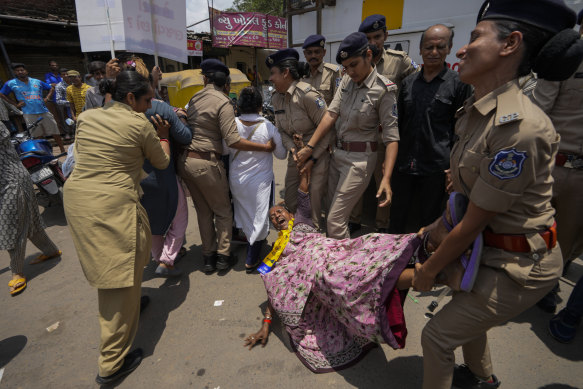
Police detains a supporter of the Aam Aadmi Party during a rally against women’s oppression in Ahmedabad.Credit: AP
“Even though the BJP tries to distance itself from some of these incidents … the violent Hindutva narrative has been given some level of legitimacy by non-action,” Bhatnagar says. The idleness pervades both the legal system and popular politics.
“Just to give you an example, Prime Minister Modi is an avid Twitter [now X] user. But whenever there is religiously motivated violence, especially against minorities like Muslims and the Sikhs, there is complete silence. This again should tell you a lot about where the priorities and allegiances are.”
Though there are certain checks and balances in place, critics nonetheless worry that the BJP in a third term will attempt to amend the Constitution to reflect a more Hindu outlook.
At the same time, India’s international heft is flowering. Economic growth has reshaped the national brand. With1.4 billion people, it is a bona fide technology giant.
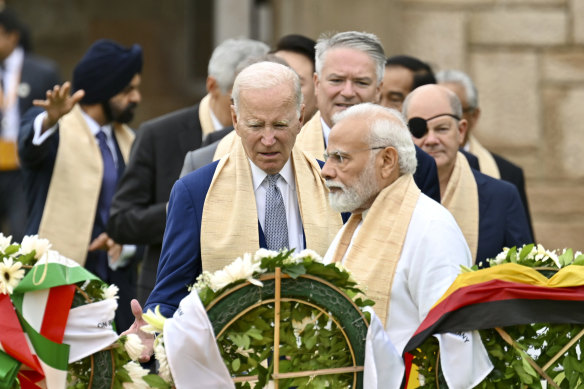
US President Joe Biden with Indian Prime Minister Narendra Modi and other G20 leaders including OECD Secretary-General Mathias Cormann and German Chancellor Olaf Scholz in New Delhi last year.Credit: AP
Importantly, it is seen by Western democracies as a counterweight to China. The ANU’s Bhatnagar says India-China ties are at one of their lowest ebbs in history, in large part because of tensions at their shared border.
Modi’s muscular and increasingly wealthy India has enchanted the Australian government, which demurs from public criticism in the name of national interest.
The BJP’s goal in this election is to control 400 of the Lok Sabha’s (lower house) 543 seats – far more than it needs to form government – through an existing coalition known as the National Democratic Alliance. To do this, it will need to gain significant ground in the more liberal south.
Loading
Bhatnagar adds other obstacles to the mix. “Essentially, India is a youth-oriented country, and the youth are struggling to get employment,” she says. “In addition, even though there has been a lot of emphasis on indigenisation of manufacturing in India, that is something they have struggled with.”
Graham Staines’ wife Gladys and daughter Esther were not travelling with the boys on January 22. They stayed in India a further five years. Sometimes, Gladys still speaks at Christian forums. She has forgiven her family’s killers.
The results from the Indian election are expected on June 4.
Most Viewed in World
Loading

